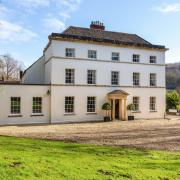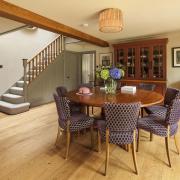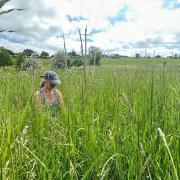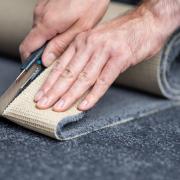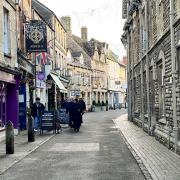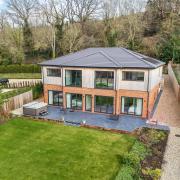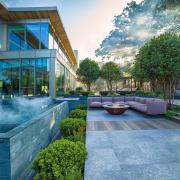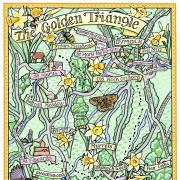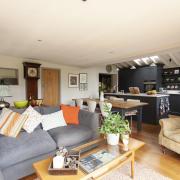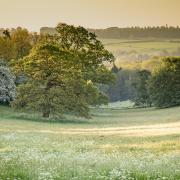Robert and Patsy Floyd’s National Trust-owned pre-Tudor home is a glamorous star of movies and historical dramas

One morning last September, Patsy Floyd glanced out of her window to see a Tudor lady gliding by. Anyone else might have thought her a ghost, but Patsy has seen many a Tudor courtier at her home Great Chalfield Manor; she and her husband Robert frequently offer their house for film shoots, and the ancient house was yet again playing its part.
‘This time it was for a film called My Lady Jane, based on the sad life of Lady Jane Grey, often called the nine-day queen,’ says Patsy. ‘Although in this case we’re told the film is a “comic supernatural tale of true love and high adventure, set in an alternate England in 1553, a country on the verge of civil war.”
‘But our home has appeared in at least six other films and tv series, including Wolf Hall, Poldark and The Other Boleyn Girl. Usually set in Tudor times.’


This is because the Grade 1*-listed house is an exceptionally beautiful example of early architecture – ‘pre-Tudor, in fact,’ says Patsy. ‘It was built in 1468. And although the National Trust owns our home, Robert and I manage the house and estate for them. Allowing films to be made here helps keep the roofs on – and we’ve done it for the last 30 years.’
Patsy’s husband Robert was brought up in the manor, as he was the grandson of Robert Fuller who rescued the very dilapidated house in the early 1900s.
‘Great Chalfield was built by Thomas Tropenell, a Wiltshire landowner who had made a fortune as a clothier,’ says Patsy. ‘He was also steward for the great landowning Hungerford family. He was actually in his sixties when he came here as he wanted to downsize!’


The stunning manor house looks pretty much as it did in 1470. ‘But this is only because of the enormous amount of work Robert’s grandfather put into restoring it,’ she says. ‘He was helped by restoration architect Harold Brakspear and garden designer Albert Parsons.’
Robert Fuller was the youngest son of the MP George Fuller who owned the vast and impressive Neston estate in Wiltshire. George bought the neighbouring Great Chalfield estate with its ancient manor house in 1878.


‘As it happened, Robert was a very successful engineer with an eye for beauty,’ says Patsy. ‘So he asked his father if he could restore this manor house and was told, yes, he could have a long lease and should employ Harold Brakspear. Which he did. And it took him from 1905 to 1912 to make the manor habitable. In 1911 he married Mabel Chappell of the music publishing family, and they moved in soon afterwards. He was able to buy the manor and land in 1913.’
But when Robert first saw it, the magnificent Great Hall had been turned into four separate rooms with false ceilings. ‘Robert opened it up to the original roof timbers which were in excellent condition,’ she says. ‘Not the case at the east end of the house where the solar is, now our Drawing Room. This had been taken down.


‘Amazingly, the only feature still intact here was the oriel window which faces north. But Robert rescued it, and the beams you can see there are only 100 years old.’ Robert also replaced the missing staircase up to the solar with another of beautiful oak, and restored the second staircase of stone which led to the bedrooms.
The Roundheads occupied the manor during the Civil War and they destroyed it further. They took down some L-shaped half-timbering, and all that is left is the south-west wing. Robert Fuller rebuilt it, keeping the half timber design.

He then converted the barn wing on the north side to create bedrooms above, with kitchen and servants’ hall below.
As for the 17th-century four-gabled dovecote above the gatehouse at the north end, this was turned into attic staff accommodation.
‘The whole building was equipped with heating, electric light and plumbing throughout, with separate rain water systems,’ says Patsy.

The architect Brakspear also designed new stables a motor house, coach house, and engine house complete with a forge. ‘As well as the potting shed which is in use every day,’ she says. ‘The rainwater tank beneath it keeps it frost free.’
As an engineer, Robert was keenly aware of the danger of flooding, as well as damp, so he had the forecourt excavated. This was to prevent water from the mill pond seeping into the foundations. The outfall of the pond became a soakaway which he had piped under the large lawn, and it then discharged into the lower moat.


Robert and Mabel also did much to restore the 13th-century parish church of All Saints which adjoins the manor forecourt; but, after the house, his main achievement was the wonderful garden he laid out.
‘We have seven acres of garden because he invited Alfred Parsons RA, a landscape painter as well as garden designer, to create them with an Arts & Crafts theme,’ she says. ‘Alfred also designed the gazebo where guests would come to watch tennis on the Great Lawn. We use it as an apple store now.’

In 1943, Robert and Mabel gave the estate to the National Trust with the wish that the family could remain there. When the Floyds took over its management 37 years ago, they gradually replanted the gardens after recruiting their gardener, Neil Brocklehurst. ‘He’s actually been here 35 years, almost as long as I have,’ says Patsy. ‘We have kept Alfred Parson’s layout and enlarged some borders; some of his roses too have survived, such as the climber Mme Caroline Testout.’
So attractive are the Arts and Crafts gardens, they are as big a draw as the house, and visitors come from all over the world to see them.

ADDRESS BOOK
Great Chalfield manor (for house and garden tours), greatchalfield.co.uk or nationaltrust.org.uk/great-chalfield-manor
Ken Biggs Contractors Ltd (heritage builders and restorers), 01761 470743, ken-biggs.co.uk
Melksham Groundcare Machinery (supply and maintain all garden machinery), 01380 828867, morethanmowers.co.uk
National Trust Film & TV locations, nationaltrust.org.uk/for-film-and-tv-lovers




